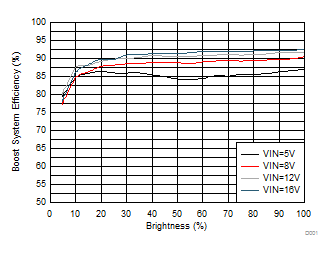SNVSAC7C October 2015 – May 2017 TPS61193-Q1
PRODUCTION DATA.
- 1 Features
- 2 Applications
- 3 Description
- 4 Revision History
- 5 Device Comparison Table
- 6 Pin Configuration and Functions
-
7 Specifications
- 7.1 Absolute Maximum Ratings
- 7.2 ESD Ratings
- 7.3 Recommended Operating Conditions
- 7.4 Thermal Information
- 7.5 Electrical Characteristics
- 7.6 Internal LDO Electrical Characteristics
- 7.7 Protection Electrical Characteristics
- 7.8 Current Sinks Electrical Characteristics
- 7.9 PWM Brightness Control Electrical Characteristics
- 7.10 Boost and SEPIC Converter Characteristics
- 7.11 Logic Interface Characteristics
- 7.12 Typical Characteristics
- 8 Detailed Description
- 9 Application and Implementation
- 10Power Supply Recommendations
- 11Layout
- 12Device and Documentation Support
- 13Mechanical, Packaging, and Orderable Information
Package Options
Mechanical Data (Package|Pins)
- PWP|20
Thermal pad, mechanical data (Package|Pins)
- PWP|20
Orderable Information
1 Features
- Qualified for Automotive Applications
- AEC-Q100 Qualified With the Following Results:
- Device Temperature Grade 1: –40°C to +125°C Ambient Operating Temperature
- Input Voltage Operating Range 4.5 V to 40 V
- Three High-Precision Current Sinks
- Current Matching 1% (Typical)
- LED String Current up to 100 mA per Channel
- Outputs can be Combined Externally for Higher Current Capability
- High Dimming Ratio of 10 000:1 at 100 Hz
- Integrated Boost/SEPIC for LED String Power
- Output Voltage up to 45 V
- Switching Frequency 300 kHz to 2.2 MHz
- Switching Synchronization Input
- Spread Spectrum for Lower EMI
- Extensive Fault Detection Features
- Fault Output
- Input Voltage OVP, UVLO, and OCP
- Open and Shorted LED Fault Detection
- Thermal Shutdown
- Minimum Number of External Components
space
Simplified Schematic

2 Applications
- Backlight for:
- Automotive Infotainment
- Automotive Instrument Clusters
- Smart Mirrors
- Heads-Up Displays (HUD)
- Central Information Displays (CID)
- Audio-Video Navigation (AVN)
3 Description
The TPS61193-Q1 is an automotive high-efficiency, low-EMI, easy-to-use LED driver with an integrated DC-DC converter. The DC-DC converter supports both boost and SEPIC mode operation. The device has three high-precision current sinks that can be combined for higher current capability.
The DC-DC converter has adaptive output voltage control based on the LED current sink headroom voltages. This feature minimizes the power consumption by adjusting the voltage to the lowest sufficient level in all conditions. For EMI reduction DC-DC supports spread spectrum for switching frequency and an external synchronization with dedicated pin. A wide-rage adjustable frequency allows the TPS61193-Q1 to avoid disturbance for AM radio bands.
The input voltage range for the TPS61193-Q1 is from 4.5 V to 40 V to support automotive stop/start and load dump condition. The TPS61193-Q1 integrates extensive fault detection features.
Device Information(1)
| PART NUMBER | PACKAGE | BODY SIZE (NOM) |
|---|---|---|
| TPS61193-Q1 | HTSSOP (20) | 6.50 mm × 4.40 mm |
- For all available packages, see the orderable addendum at the end of the data sheet.
System Efficiency

4 Revision History
Changes from B Revision (April 2017) to C Revision
- Enhanced pin descriptions for pins 3, 10 and 16 in Pin FunctionsGo
- Deleted "Dimming ratio is calculated as ratio between the input PWM period and minimum on/off time (0.5 µs). " from Brightness ControlGo
Changes from A Revision (October 2016) to B Revision
- Deleted "IOUT = 100 mA" from tON/OFF row of Table 7.9Go
- Changed "0.5" from MAX to TYP column in tON/OFF row of Table 7.9 Go
- Added table note 1 for Tables 7.9 and 7.10Go
- Deleted "Initial DC-DC voltage is about 88% of VMAX BOOST." from Integrated DC-DC Converter; change wording in last sentence before equation 1.Go
- Changed eq. 1; added "K" eq definitions for eq. 1 and paragraph after Fig. 9 Go
- Added new paragraph before Internal LDOGo
Changes from * Revision (October 2015) to A Revision
- Changed several wording of several items in Features Go
- Changed "High Dimming Ratio of 10 000:1 at 200 Hz" to "High Dimming Ratio of 10 000:1 at 100 Hz"Go
- Changed some wording in Description - for clarity; additional several newApplicationsGo
- Added Device Comparison Table Go
- Added Figures 7 and 8 - new graphsGo